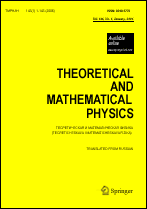|
This article is cited in 4 scientific papers (total in 4 papers)
Krylov–Bogoliubov–Mitropolsky averaging used to construct effective Hamiltonians in the theory of strongly correlated electron systems
A. P. Saiko
Theoretical and Practical Center in Physical Metallurgy,
Belarus National Academy of Sciences, Minsk, Belarus
Abstract:
We show that the Krylov–Bogoliubov–Mitropolsky averaging in the canonical formulation can be used as a method for constructing effective Hamiltonians in the theory of strongly correlated electron systems. As an example, we consider the transition from the Hamiltonians of the Hubbard and Anderson models to the respective Hamiltonians of the $t$–$J$ and Kondo models. This is a very general method, has several advantages over other methods, and can be used to solve a wide range of problems in the physics of correlated systems.
Keywords:
Krylov–Bogoliubov–Mitropolsky averaging, effective Hamiltonian, Hubbard model, $t$–$J$ model, Anderson model, Kondo model.
Received: 19.12.2008
Revised: 12.03.2009
Citation:
A. P. Saiko, “Krylov–Bogoliubov–Mitropolsky averaging used to construct effective Hamiltonians in the theory of strongly correlated electron systems”, TMF, 161:2 (2009), 287–294; Theoret. and Math. Phys., 161:2 (2009), 1567–1572
Linking options:
https://www.mathnet.ru/eng/tmf6439https://doi.org/10.4213/tmf6439 https://www.mathnet.ru/eng/tmf/v161/i2/p287
|


| Statistics & downloads: |
| Abstract page: | 1391 | | Full-text PDF : | 340 | | References: | 91 | | First page: | 49 |
|




 Contact us:
Contact us: Terms of Use
Terms of Use
 Registration to the website
Registration to the website Logotypes
Logotypes









 Citation in format
Citation in format 
